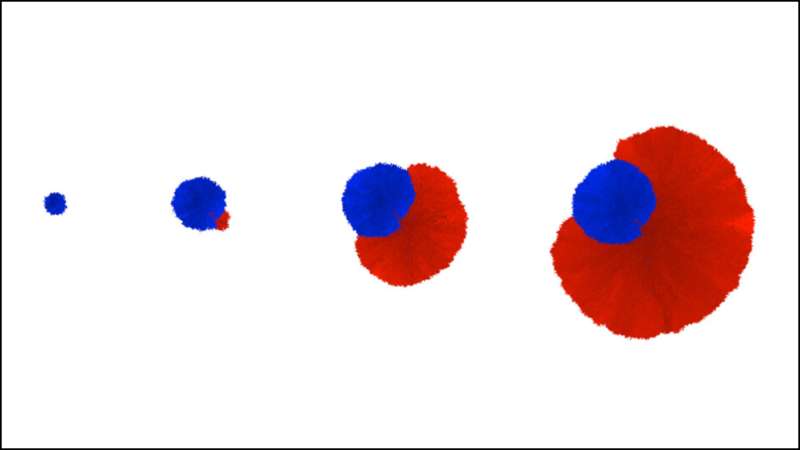Mapping how evolutionary forces affect cancer growth could help doctors choose biopsies

A computer model that uses the principles of evolution to map the growth of populations of cancer cells in tumors could help doctors choose where to take biopsies from tumors, improving decisions about treatment.
The model, which shows how cancer cells with particular mutations can spread through tumors, could more accurately reflect the genetic picture across whole tumors.
Doctors use tumor biopsies—samples taken from cancer—to learn about what is happening inside cancers and decide which treatments are likely to be effective.
Mapping the patterns of cell spread
Doctors will often take several biopsy samples from tumors and use DNA sequencing to identify mutations that can be targeted for treatment.
However, biopsies do not always reflect the full diversity of mutations that make up a tumor.
Imagine trying to build up a picture of a dartboard, just from where your limited number of darts land. You could get a very different picture depending on where the darts land, which doesn't represent the true structure of the board.
In the same way, relying on a small number of biopsies may miss details and not reflect the full diversity of mutations that make up a tumor.
If researchers could better map the patterns of cell spread through tumors, doctors could take biopsies from tumor locations that best reflect the disease's biology.
The model, developed by scientists at The Institute of Cancer Research, London in collaboration with the Barts Cancer Institute and published in PLoS Computational Biology, shows how populations of cells with distinct sets of mutations spread through tumors.
The model accounts for the presence or absence of selective evolutionary pressure—in which conditions favor the survival of cells with certain genetic traits—and the presence or absence of physical, spatial constraints in tumors.
The ICR scientists who co-developed the model are based in our Centre for Evolution and Cancer—and are due to move into our new Centre for Cancer Drug Discovery, where they will be part of the world's first "Darwinian' drug discovery program.
Modelling tumor evolution
The researchers' model predicted that populations of cells with shared genetic characteristics grow in clumps or spreading out in strands, depending on the conditions.
These patterns look chaotic but they follows the rules of evolution, and importantly the models mimicked patterns of growth seen in real tumors.
The research was largely funded by the Medical Research Council and the Wellcome Trust, with further support from organizations including Cancer Research UK and the US National Institute of Health.
Study leader Professor Andrea Sottoriva, Professor of Cancer Genomics & Evolution and Director of the ICR's Centre for Evolution and Cancer at the ICR, said: "Tumor biopsies tell us a great deal about the biology of a patient's cancer, but evolutionary forces lead to differences in cancer cells across space and time, and biopsies only give an incomplete picture.
"Our study helps to clarify the effect of evolutionary forces on the spread of genetic mutations across tumors. We hope, in the future, our modeling will help doctors to select the treatments most likely to counteract individual tumors, more effectively than they can with current methods to collect and analyze biopsies."
More information: Ketevan Chkhaidze et al. Spatially constrained tumour growth affects the patterns of clonal selection and neutral drift in cancer genomic data, PLOS Computational Biology (2019). DOI: 10.1371/journal.pcbi.1007243
Journal information: PLoS Computational Biology
Provided by Institute of Cancer Research





















